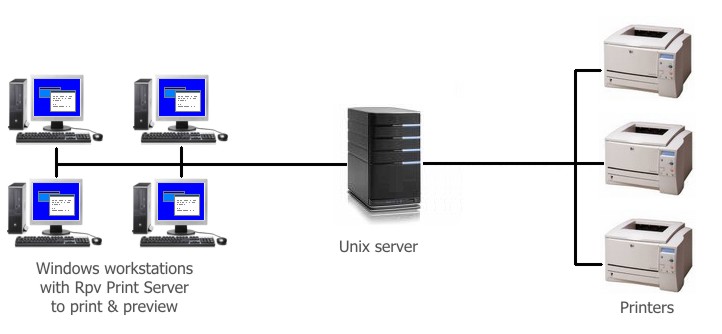Using Rpv Reports on a unix network
First of all, we must say that unix is a generic name. We mean any "x" operating system such as Linux, Qnx, Sco-Unix, Solaris, etc.
Rpv Reports can be connected to a unix system in different ways:
Using Samba or similar software
Samba provides access to Unix just like if it was a local machine. In this case,
we suggest to use Samba instead FTP.
In that case, the FTP capability will not be used and, in fact the print server
will not be required. In some cases, and depending on what is necessary, the
print server can be replaced with the Rpv viewer and the RpvPrint.exe utility.
The http protocol
When the report viewer is opened, it shows an address bar. It is possible to
open a report that is on an http server. It is possible also to open the report
viewer specifying a file name in the command line. The file, images and includes
that the file could refer can be hosted on an http server.
Alternatives to use Rpv Reports with Unix without Samba.
In any of the following cases the FTP queue
capability will be required. It will be necessary that the unix server has
an FTP server running on it. (see specifying the remote FTP queue for the
server)
a) Using the print server to preview and print the files using FTP queue.
It is possible to preview, and of course to print the reports using Unix and
Rpv under certain configuration:
What is needed to perform this task is to have
Windows workstations using telnet to the Unix system. In this case, Rpv will run
on the 'Windows side' of the computer and will be able to open the reports that
are on the Unix computer previewing them on the workstation. See
previewing a report from a telnet session

b) Using the print server only for printing.
This will not be the most desirable
scenario.
However, it will be the only available if the workstations are not Windows. If
the system has only terminals and the only possibility is to connect to the server,
then it will be needed to have one computer that runs Windows and acts as Print
Server.
On this configuration, the print server
will be installed on the Windows computer only and will manage the reports
sending them to the printer automatically.

How to print a report under these configurations.
Once the print server is running on the Windows machine (figure 1 or 2), searching for reports on the unix server (in its queue directory), just place the reports that you want to be printed on the unix server queue directory and the application will print them throught its printers (these reports can be all the reports accepted by Rpv, this means TXT, LST and PRN files too).
Example:
# mv /usr/rpv/report1.rpv /tmp/rpvqueue
This example shows, from unix prompt, how to print an rpv report that is placed in the directory /usr/rpv sending it to the directory /tmp/rpvqueue supossing that "/tmp/rpvqueue" is the unix server queue directory and the application will read it.
|
It is required to MOVE the files once they have been created and closed and not to create them on the queue directory to avoid the print server finds the files before they are done. |
About the images.
The most desirable is to have all images (logos for example) on the computer that has the Rpv installed. Having the images on the Windows computer will allow the print server to transfer the reports faster. Anyway, if the images are not in the Windows computer, all you have to do is to place them on the unix server queue directory. When Rpv finds any report it transfers all the files, including the graphics, includes, etc.
Another good option is to have the images on a server that Rpv can access via local or http. The alternative to place the images on the queue directory on the Unix server is not the most desirable because it obligates the Print Server to download all of them time after time.
Xtod / Unix2dos
Xtod y Unix2Dos are commands available on Sco-Unix and Linux respectivelly. Depending on the version of Unix, the name of the command could vary. These commands convert Unix text to Windows text, needed by Rpv. Ussually is not necessary to convert texts. However, and depending on the Unix server that creates these files, is possible that they should be converted prior the copy to the queue path.
| Compatibility:
although is desirable that this feature is compatible with all the FTP
servers available, there are certain incompatibilities with some of them,
according the format they use to provide the data to the Rpv Print
Server. |